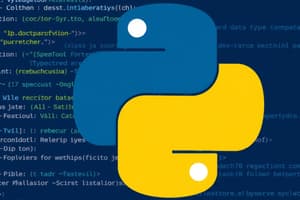Podcast
Questions and Answers
What is the primary function of the Central Processing Unit (CPU) in a computer?
What is the primary function of the Central Processing Unit (CPU) in a computer?
- It stores data permanently even when the computer is off.
- It serves as the main interface for user interactions.
- It manages input and output devices.
- It runs programs and processes instructions. (correct)
Which of the following statements best describes main memory?
Which of the following statements best describes main memory?
- It is a type of volatile memory for temporary data storage. (correct)
- It holds the operating system permanently.
- It is used exclusively for data output devices.
- It retains data after the computer is turned off.
What role does a programmer play in the context of computer systems?
What role does a programmer play in the context of computer systems?
- They only develop content for educational purposes.
- They primarily focus on maintaining hardware components.
- They ensure the computer's operating system is up to date.
- They design, create, and test programs to instruct the computer. (correct)
Which of the following best defines software?
Which of the following best defines software?
What is true regarding microprocessors in relation to CPUs?
What is true regarding microprocessors in relation to CPUs?
What is a characteristic of solid state drives (SSD) compared to hard disk drives (HDD)?
What is a characteristic of solid state drives (SSD) compared to hard disk drives (HDD)?
Which of the following statements about input devices is correct?
Which of the following statements about input devices is correct?
What best describes the role of application software within a computer system?
What best describes the role of application software within a computer system?
Which of the following correctly defines a byte?
Which of the following correctly defines a byte?
In the context of secondary storage, what is a common use of flash memory?
In the context of secondary storage, what is a common use of flash memory?
Flashcards are hidden until you start studying
Study Notes
Introduction to Computers and Programming
- Computers are designed to execute a set of instructions known as programs, which are essential for tasks like word processing or presentations.
- Software refers to all programs that enable a computer to perform its functions.
- Programmers or software developers create, design, and test these programs.
Hardware and Software
- Hardware comprises the physical components of a computer, working in tandem as a system.
- Major hardware components include:
- Central Processing Unit (CPU): executes programs and is critical for software operation.
- Main Memory (RAM): temporary storage for programs running and data in use, characterized as volatile memory.
- Secondary Storage: retains data long-term, with types including Hard Disk Drives (HDD), Solid State Drives (SSD), and Flash memory.
- Input Devices: components used to collect data from users (e.g., keyboard, mouse).
- Output Devices: formats and presents data from the computer (e.g., monitors, printers).
Central Processing Unit (CPU)
- The CPU is the primary component that processes instructions, crucial for running software.
- Microprocessors are a compact version of CPUs, found on small chips.
Memory and Data Storage
- Data in computers is represented as binary sequences (0s and 1s).
- A byte is the smallest data unit, consisting of eight bits, and can hold a character or small number.
- Bits represent two values: 0 and 1; binary system uses positional values to calculate numeric representation.
- ASCII (128 characters) and Unicode (more comprehensive, supports multiple languages) are standard coding systems for characters.
Program Execution
- The CPU performs operations by fetching instructions from memory, decoding them, and executing them in a constant cycle.
- Programs need to be loaded from secondary storage to RAM for execution.
Programming Languages
- Machine language is not user-friendly; thus, assembly language simplifies programming using mnemonics.
- High-Level Languages, such as Python, allow for easier program creation without needing detailed CPU knowledge.
- Key aspects when writing programs in high-level languages include:
- Keywords: predefined terms with specific meanings.
- Operators: perform operations on data (e.g., arithmetic).
- Syntax: rules for constructing valid statements.
Compilers and Interpreters
- High-level languages require translation into machine language for execution.
- Compilers convert the entire program into machine language for later execution.
- Interpreters, like those used in Python, translate and execute code line by line, providing immediate feedback.
Using Python
- Python requires installation, including the interpreter, for programming.
- Python can be used in two modes:
- Interactive Mode: users input statements directly; useful for learning and testing.
- Script Mode: users save commands in a file with a .py extension, executed via command line (e.g.,
python filename).
Error Handling
- Errors encountered during the coding process are indicated, with syntax errors preventing code translation into machine language.
- Interactive mode offers immediate feedback, aiding in correcting mistakes.
Studying That Suits You
Use AI to generate personalized quizzes and flashcards to suit your learning preferences.




